Fashion
5 Ridiculous Men's Underwear Trends In History

Women have had a thoroughly silly time of it in the history of underwear (farthingales, anybody?), but men haven't been let off all that easily either. The modern age of tighty-whiteys versus boxers may make it seem as if it's always been fairly straightforward for dudes, but in reality they've had periods where it was de rigeur to strap fake calves to your legs, bulk up their cocks with stuffed jewelled codpieces, or wear electric vibrating belts under their clothes. If you thought the jockstrap was as weird as it got in men's underwear history (and, admittedly, that is pretty goddamn weird), sit tight, young grasshopper: things are about to get very odd.
For quite a lot of history, men either had loincloths or not much in the way of underclothes at all; men of Mr. Darcy's period, for instance, didn't really have breeks, underpants, or anything custom-made; instead, they tucked their shirt-tails between their legs. These days underwear is mostly caught up in controversies about whether it affects sperm count, or in space-age inventions that block radiation around the crotch, but it's had a history of serious vanity, discomfort, and hilarity. (Though nobody made them wear thongs.)
Here are the five most ridiculous men's underwear trends in history.
1. Stays
Thought corsets were just for women? Nope. For a brief period in the 1820s and 30s, fashionable men indulged in waist-tightening devices of their own to fit into the svelte silhouette of the time. Apparently stays, which wrapped around the waist under your shirt like a cummerbund, first emerged in the military and as aids to exercising (keeping posture straight and the tummy tucked in), and then gradually filtered into formalwear for dudes at the top of society. You weren't anybody unless you had a teeny waist.
They weren't called corsets or stays by the people who wore them, though: they opted for the more masculine terms "belts," or, weirdly, "girdles". An Italian traveller, Giacomo Beltrami, recounted an evening in 1820s America where he protected himself "with my cutlass in my girdle". Either way they fell out of fashion pretty fast, and male tummies were back in. Because of course.
2. Artificial Calves
Introduced in the 1770s in Europe, these were popular among a subset of men who wanted to accentuate their calf muscles, and so strapped on some artificial "padding" underneath the close-fitting stockings that were popular at the time. In The History Of Underwear, Phillis Cunnington says the idea was probably introduced by "macaronis," serious dandies who dressed outlandishly and paid too much attention to fashion. (Remember Yankee Doodle Dandy 's "stuck a feather in his cap and called it macaroni"? That's the same thing.)
The importance of a well-turned leg on men was actually a pretty serious historical trend. Aristocrats in 17th and 18th century England appear to have regularly raced their footmen in "walking" races, a trend called pedestrianism, and footmen themselves were often rated by the handsomeness of their legs and calves.
3. Thigh Pads
Blame the 1820s for this one, too: the fashion of the time was for exceptionally tight-fitting pantaloons with absolutely no forgiveness, and the silhouette was meant to be for taut thighs and svelte ankles. If they didn't fit this stocking-like aesthetic, it seems that dandies just invented it, by strapping pads made of stuffing to their thighs.
Herman Melville, author of Moby Dick, thought this was a spectacularly stupid idea. "Stripped of the cunning artifices of the tailor... what a sorry set of round-shouldered, spindle-shanked, crane-necked varlets would civilised men appear!" he lamented. "Stuffed calves, padded breasts, and scientifically cut pantaloons would then avail them nothing, and the effect would be truly deplorable."
4. Codpieces
The codpiece, which was designed originally just as a covering flap, became a serious fashion accessory in Europe starting in 1400, when it started to become more ornate and decorated with jewels. Its name in French, hilariously, was the "baguette". It reached its full height in the court of King Henry VIII, where artificial codpieces padded with horsehair, cotton, and wool were thoroughly in vogue, with pantaloons designed to make them the visible "focus" of an outfit. Some even curved upwards. It was all meant to emphasise virility and masculinity, though it probably looked utterly peculiar in person.
One (slightly disgusting) theory about the enlargement of the codpiece over time is that they got bigger to conceal the symptoms of syphilis, which was raging throughout Europe at the time. Syphilis causes swellings and means the genitals have to be bandaged and padded with medicine-soaked material, so a codpiece was a handy "holder" for a very painful medical situation. Slightly less silly in retrospect.
5. Heidelberg Belts
Back in 1900, the Sears catalogue featured a new and exciting (indeed, electrifying) invention: the Heidelberg Belt. Designed to be worn under the clothing, the new underwear accessory purported to use the powers of electricity to cure basically anything you could name. If you wanted an electric current gently pulsing near your nethers, you were in luck. It was part of the fad for electricity as a medical cure-all, though precisely how it worked remained unclear.
The makers claimed it was actually a unisex item, saying it could be used "for weakness in men and women, personal exhaustion bringing back lost strength and power, over brain work, vitality, impotency, rheumatism, sciatica, lame back, railroad back, insomnia, melancholia, kidney disorder, Bright's disease, dyspepsia, disorders of the liver, female weakness, poor circulation, weak heart action and almost every known disease and weakness." It's not the only one of its type, either. Dr Sanders' Electric Belt, dating from 1895, claimed to cure drug addiction, and included a handy loop to place around your genitals. (Vibrators for women were marketed similarly.) Next Christmas present, anybody?
Images: History Of Underclothes, Wikimedia Commons, Art Institute Of Chicago, Giovanni Battista Moroni, Wikimedia Commons